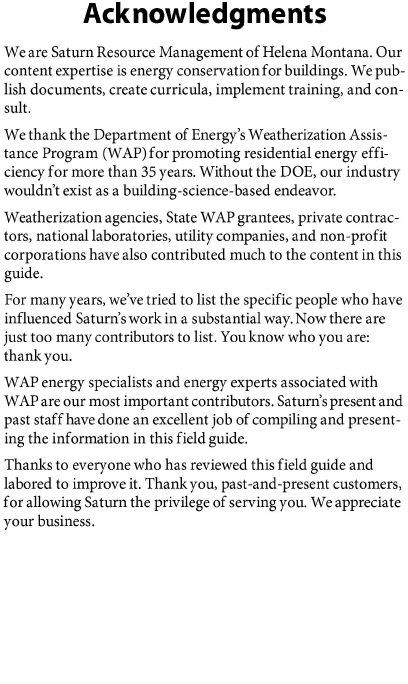


Preface
This Weatherization Field Guide outlines a set of best practices for the Weatherization Assistance Program (WAP). Weatherization experts collaborating with the National Renewable Energy Lab (NREL) developed the Standard Work Specifications (SWS) beginning in 2009. These new SWS standards reside online in NREL’s SWS Tool.
The SWS presents details and outcomes for weatherization measures that are required when a weatherization agency selects a weatherization measure, based on its cost effectiveness. The technical content of this guide aligns with the SWS requirements.
The Minnesota Weatherization Assistance Program (MN WAP) encourages the house-as-a-system approach to building-performance improvements. Not all measures in this field guide are allowable in MN WAP. Some non-allowed measures are included to provide a broad spectrum of solutions that may be feasible using other programs and funding sources. Always check with MN WAP policy, if you have a question whether a measure mentioned in this field guide is allowable.
A major purpose of this guide is to show how its contents are aligned with the SWS. Therefore, we’ve inserted hypertext references to the specific SWS details that our content aligns to. When you click on one of these references, the relevant detail appears in your browser.
This guide also incorporates information from the following standards and specifications.
• DOE Weatherization Job Task Analysis (2013)
• Building Performance Institute’s (BPI) relevant standards
• WAP Policy Directives from 2005 to 2013
• International Residential Code 2012
• International Energy Conservation Code 2012
• Standards for combustion systems by The National Fire Protection Association (NFPA) 2009 editions, including NFPA 54, 31, and 211
We begin this guide with health and safety, an important topic for both workers and clients. The first part of the chapter discusses client health and safety. The last part of the chapter covers worker health and safety.
Next, the guide presents a chapter on energy auditing, inspecting, customer relations, and work flow development. The following chapter discusses insulation and air sealing materials and their characteristics. We follow that with four chapters on the four distinct parts of the building shell: attics and roofs; walls; floors and foundations; and windows and doors.
The guide’s largest chapter is heating and cooling. We created a separate chapter on ventilation, which includes whole-house ventilation, local ventilation, attic and crawl-space ventilation, and ventilation for cooling.
We’ve included a dedicated chapter on mobile homes where we discuss the ECMs particular to mobile homes. In this chapter we often refer to other sections of the guide that contain information that’s relevant to both mobile homes and site-built homes.
The last chapter’s topic, Air Leakage Diagnosis, is an effective tool for weatherization agencies to guide cost-effective air sealing. This chapter doesn’t align to the SWS because the SWS doesn’t detail testing procedures.
Like the SWS, this field guide is a living document and a work-in-progress. The field guide will change as the SWS changes. We hope you find this guide authoritative, easy to use, and well aligned to the SWS. We welcome all comments, suggestions and criticism. Thanks for your hard work and dedication in implementing the Weatherization Assistance Program.
